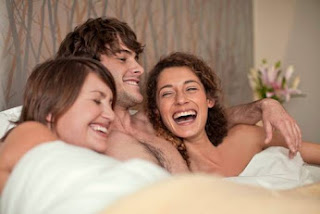Bisexuality Does Exist
 Hoping to offer bisexuals a supportive community in 2010, Lawrence became the head organizer for am Bi, a bisexual social group in Los Angeles. “All kinds of people show up to our events,” he told me. “There are older bi folks, kids who say they ‘don’t need any labels,’ transgender people — because many trans people also identify as bi. At our events, people can be themselves. They can be out.”
Hoping to offer bisexuals a supportive community in 2010, Lawrence became the head organizer for am Bi, a bisexual social group in Los Angeles. “All kinds of people show up to our events,” he told me. “There are older bi folks, kids who say they ‘don’t need any labels,’ transgender people — because many trans people also identify as bi. At our events, people can be themselves. They can be out.”
“Though most bisexuals don’t come out,” Sylla said. “Most bisexuals are in convenient opposite-sex relationships and aren’t open about their sexual orientation. Why would you be open, when there is so much bi-phobia?
 Spend any time hanging around bisexual activists, and you’ll hear a great deal about bi-phobia. You’ll also hear about bi erasure, the idea that bisexuality is systematically minimized and dismissed. This is especially vexing to bisexual activists, who point to a 2011 report by the Williams Institute — a policy center specializing in L.G.B.T. demographics — that reviewed 11 surveys and found that “among adults who identify as L.G.B., bisexuals comprise a slight majority.” In one of the larger surveys reviewed by the institute (a 2009 study published in The Journal of Sexual Medicine), 3.1 percent of American adults identified as bisexual, while 2.5 percent identified as gay or lesbian. (In most surveys, the institute found that women were “substantially more likely than men to identify as bisexual.”)
Spend any time hanging around bisexual activists, and you’ll hear a great deal about bi-phobia. You’ll also hear about bi erasure, the idea that bisexuality is systematically minimized and dismissed. This is especially vexing to bisexual activists, who point to a 2011 report by the Williams Institute — a policy center specializing in L.G.B.T. demographics — that reviewed 11 surveys and found that “among adults who identify as L.G.B., bisexuals comprise a slight majority.” In one of the larger surveys reviewed by the institute (a 2009 study published in The Journal of Sexual Medicine), 3.1 percent of American adults identified as bisexual, while 2.5 percent identified as gay or lesbian. (In most surveys, the institute found that women were “substantially more likely than men to identify as bisexual.”)

Comments
Post a Comment